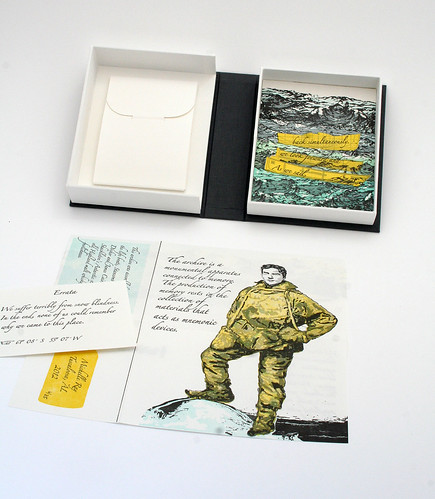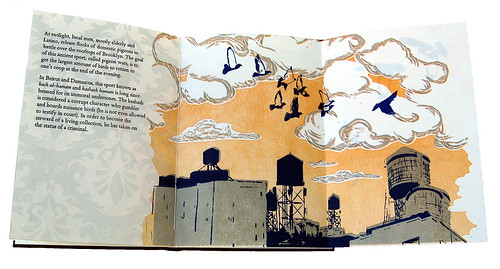Turning appointments into encounters: transforming collection development visits into enriching experiences with faculty, students, and community
Guest Post by Sha Towers – originally posted on the ARLIS SIG blog, November 2014
For librarians, collection development work often means combing catalogs and websites and placing an order without having seen the material in person. While this can certainly be a route to collecting artists books, another (more?) common route into library collections begins with an artist or dealer making an appointment with a librarian to show their work. From my earliest experiences meeting with book artists and dealers, I remember thinking “Oh, I wish so-and-so were here to see this!”, so much so that in with the next few appointments, I invited other colleagues in the libraries to join in because I knew they would be intrigued with this medium.
In a desire to “share the love” even wider, I began inviting some art faculty members to sit in on these appointments. This generated interest in how book arts might be used in their courses and we soon began setting up appointments with artists and dealers to coincide with class times of specific art department courses so that the students could experience the works in something of an “open house viewing.” Such sessions grew into more formal presentations during visits with Bill and Vicky Stewart of Vamp and Tramp Booksellers.
In these sessions Bill and Vicky would serve as artists book guest lecturers using as examples, items from the Baylor Book Arts Collection as well as new work that they brought with them, followed by an opportunity for students and faculty to explore the new works. I still used these visits as chance to review new work, but by inviting students and faculty join in on the experience and talk about which works they responded to, I was able to incorporate works that were particularly meaningful to them into our collection. This approach has strengthened connections between librarian and art faculty, librarian and students, faculty and collections, and students and collections.
At Baylor, the book arts collection is used primarily as a teaching collection for studio arts. Individually or as a class, students use the collection as a source of inspiration for their own works as well as studying structural concepts or construction techniques.

Vicky and Bill Stewart (Vamp and Tramp Booksellers)
presenting at Baylor University Libraries, 2010. Photo by Sha Towers
The earliest group encounters happened in the library, but as interest grew, I found myself needing to find larger and larger spaces as more than one section or course would gather for these encounters. As my goal was to involve more art students and faculty, I approached the department chair and museum director about holding the next encounter in the museum gallery (located within the art department). My favorite moment during this encounter was when an art student ran out of the gallery to go down the hall to find another of his instructors because he just HAD to show them this amazing artists book he’d just seen.
Being in close proximity to all the relevant players definitely has advantages. For the next session, we moved the location to the foyer outside the gallery, which afforded much greater visibility and allowed for more classes to visit during the day. This location prompted a number of “drop in” faculty and students as well as a couple faculty members asking “can I bring my class that’s about to start?” Holding these events on “their turf” (instead of in the library) had a positive impact on attendance, departmental investment, and connections between the art department and their librarian. Connections were enriched not only with faculty and students, but also with administrative and museum staff. We’ve used these encounters as a unique opportunity for people to view much more work than they would ever have a chance to see on their own, especially since our collection budget could only allow us to acquire a tiny fraction of what’s available. Now I will rarely schedule appointments with artists or dealers that can’t be converted into an encounter for a larger audience.

Vicky and Bill Stewart (Vamp and Tramp Booksellers)
presenting at Indiana University, 2013. Photo by Herron Library Staff Photographer
These encounters benefit the students and faculty by giving them direct involvement and ownership in building the book arts collection. They are more invested in the collection since they’ve had a hand in building it. They also see their librarian as in-touch with and responsive to their needs and it keeps me on their radar. Benefits to me as a librarian include more opportunities for networking with students and faculty, more buy-in for the collection and more support for additional purchases. I have a clearer sense of what types of works resonate with the collection’s users and because of this, use of the collection is growing.
The next step in the evolution of these events moved to an even larger audience, taking what would have been a collection development appointment with a book artist Peter Thomas and turning it into a public event beyond the walls of the art department. For this visit, Peter brought his gypsy wagon and parked it in front of the busy, main campus library (great advertising and promotion, by the way!) and then gave a public artist talk in the library foyer. The event was advertised with posters across campus, front-page article in the campus newspaper, and on Twitter and Facebook. About seventy five people from the community and various parts of campus attended the talk, which was followed by a viewing of his artists books and his gypsy wagon.
When I meet with students and faculty in these sessions, they see the perspective of librarian as curator and collector. When book artists and dealers are a part of the equation, the experience is greatly enriched with the perspectives of working professional artists, promoters, and people involved in the business end of the arts.
It would certainly be easier to just meet one on one with artists and dealers to look at their work and consider acquiring work for my library’s book arts collection, but it wouldn’t be as fun or as enriching – for me or the others that I’ve invited to join the circle. For more information about the Baylor Book Arts Collection, visit: www.baylor.edu/library/finearts/bookarts



Peter Thomas, public artist talk event, Baylor University Libraries, 2013. Photos by Sha Towers and Carl Flynn.
ShaTowers is the Art Liaison Librarian and Director of Liaison Services at Baylor University in Waco, Texas. Prior to that he served for twelve years as the head of the Fine Arts Library at Baylor. He first encountered artists books in 2007, promptly fell in love with the medium, and began building a collection which now numbers nearly 600 works. He is also the Vice Chair/Chair Elect of the Texas-Mexico chapter of the Art Libraries Society of North America.
















































 Cases were unlocked and books removed by Special Collections Librarian Kate Crowe. Had the exhibit not been on display, a similar field trip to the Gottesfeld Room for a closer look at artists’ books could have just as easily been arranged.
Cases were unlocked and books removed by Special Collections Librarian Kate Crowe. Had the exhibit not been on display, a similar field trip to the Gottesfeld Room for a closer look at artists’ books could have just as easily been arranged.





